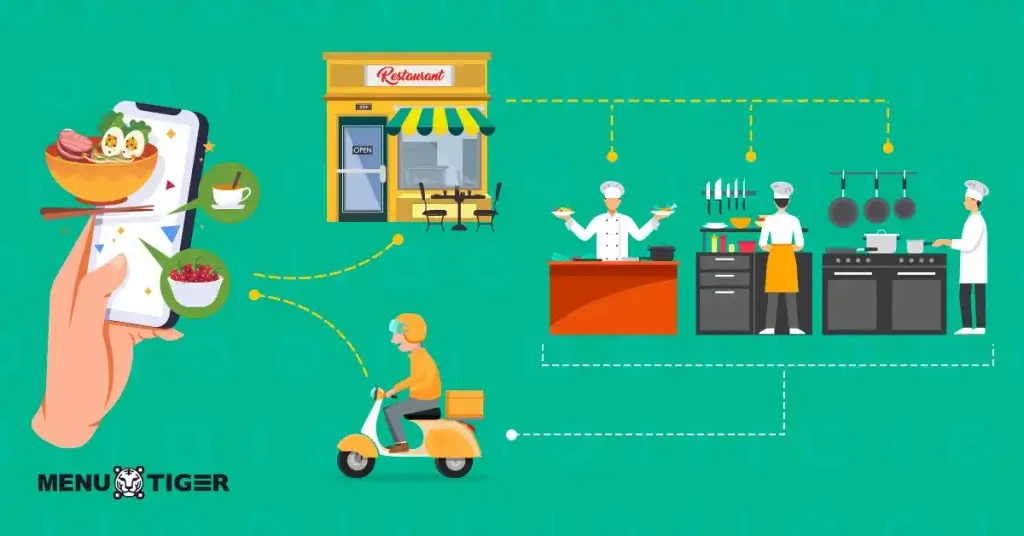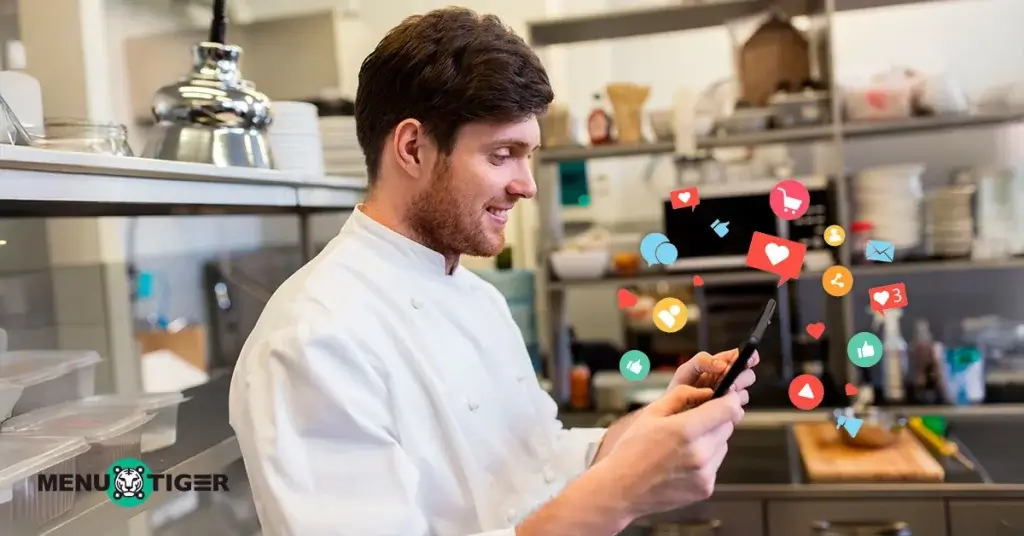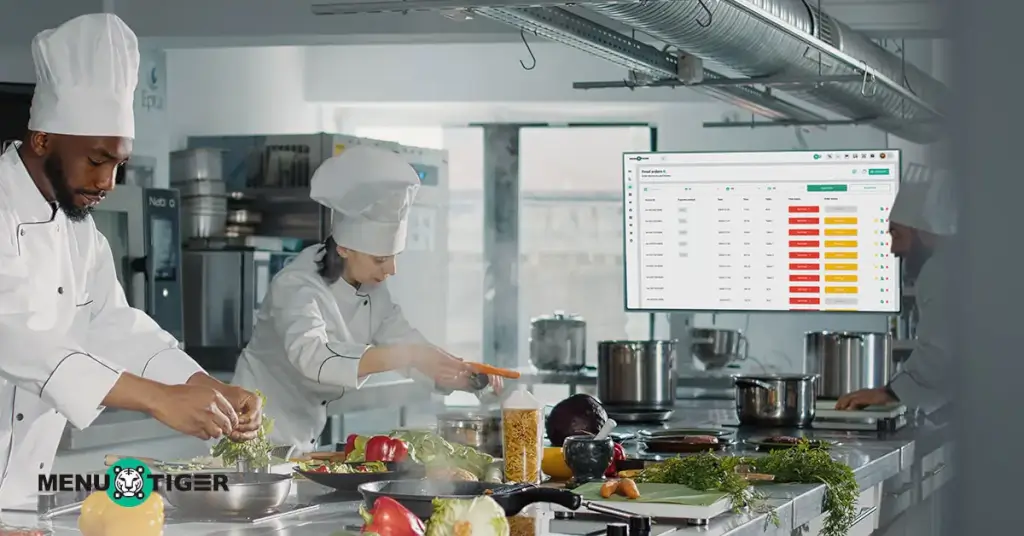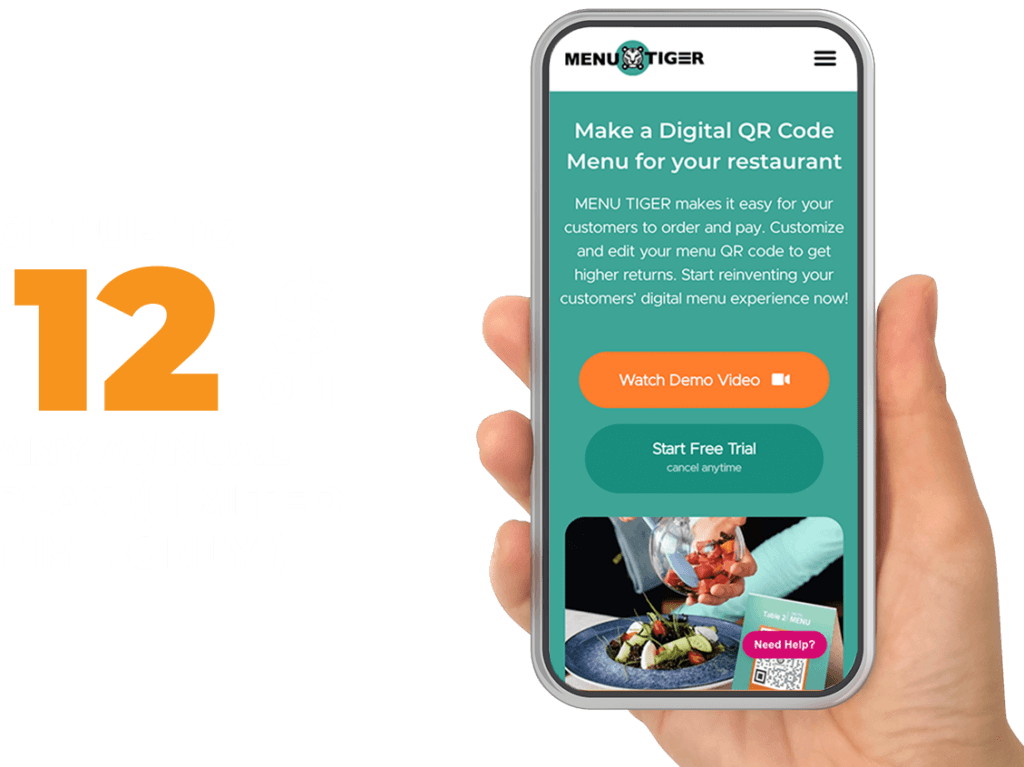Ghost kitchens serve consumers with exceptional restaurant-caliber food without a staff but just delivering the dining experience to their doorsteps.
IBISWorld records report that there were 7,594 kitchen businesses in the US in 2023, a 1.2% decrease from 2022.
Coherent Marketing Insights also revealed that the global ghost kitchen market was valued at around $70.37 billion in 2023 and is projected to reach $156.60 billion in 2030.
This only reinforces how this new food service is dominating the industry and changing how consumers perceive the traditional setup, particularly those who prefer to use a digital online menu system and delivery.
So, if you are interested in trying this innovative way of offering a dining experience to your customers, here are a few things you need to do to launch it successfully.
Table of Contents
ToggleWhat is a ghost kitchen?
A ghost kitchen, also known as a virtual or dark kitchen, is a food preparation facility that operates exclusively for delivery and, in some cases, pick-up orders.
It doesn’t have dine-in spaces for customers and often functions as a behind-the-scenes hub for multiple food brands.
Here are a few of its characteristics:
- Businesses like this operate in a commercial kitchen or shared cooking space, either rented or built, as they don’t have a physical location.
- It is delivery-focused and operates mainly through online order apps or in-house delivery services that they offer.
- It also offers low overhead costs since there’s no need for a dining area, decor equipment, or front-of-house staff, reducing restaurant cost compared to traditional restaurants.
- Because it functions online, it needs to be technology-driven, relying heavily on tech for order management, inventory tracking, and customer interactions.
What is the structure of different ghost kitchen businesses?
Although ghost kitchens may seem to operate in one business operation, but they’re operating in different structures. So, before setting up your own, consider which is right for you.
Restaurant-owned locations
This concept, which independently owns and operates its operations, is most comparable to the traditional brick-and-mortar setup.
The same way it comes with the same risks when looking for the right location, stocking, hiring staff, and maintaining the kitchen.
Here are a few things to consider if you own a ghost kitchen:
- Some restaurants want to be controlled entirely, and others would wish to have assistance from third-party services.
- Make sure that you manage your finances well. It’s critical since you don’t have table turnovers.
- Start small and expand when you’re ready.
- Think of an innovative marketing strategy to implement for this new restaurant concept. It must face the traditional ones head-on to gauge whether this new business model can drive sales.
Third-party commercial kitchens
Shared kitchens are fully equipped, professional-grade spaces for food businesses. They don’t promote brands but provide a space and the tools you need to start cooking.
Offshoot locations of a successful brand
This restaurant concept grows its reach with less cost, risk, and hassle than opening a full restaurant. Use a proven menu and pair it with the fast, reliable delivery customer expect.
Some offshoots offer curbside pickup and delivery, while others operate entirely from dark kitchens with no in-person service. It’s not just big chains doing this, the local restaurants also use ghost kitchens to expand on their own terms.
Spoke-and-hub system
This model is similar to offshoot locations but works differently.
Instead of each location being self-sufficient, a central hub supplies and supports smaller spoke outlets like food trucks or dark kitchens.
If you managed this well, this kind of setup can use local sources efficiently, reach customers effectively, and generate consistent revenue.
Delivery-only concept
These kitchens focus solely on preparing high-quality meals for delivery, skipping the traditional dine-in experience entirely. They can be owned and run under different business structures, but the goal is the same: restaurant-level food with delivery convenience.
Starting one is similar to opening a regular restaurant, but without the costs tied to in-person dining. You don’t need to pay for customer bathrooms, decor, dining furniture, front-of-house staff and systems, or rent for a large dining area.
9-step guide in setting up your ghost kitchens
Putting up an online restaurant like this may have a slightly different approach to the conventional one that you’re used to.
To get you locked and loaded, here’s a comprehensive guide on how:
1. Understand the Ghost Kitchen Model

Every business model of this particular food service operates differently based on the capacity of your team members, the number of brands you want to accommodate, and the goal you’re envisioning for the business.
So, having to understand each will help you determine the flow of your ghost kitchen.
There are three types of business models:
- By ownership
If you’re up for making it or striking it all your own, then the ownership business model suits you best.
Building an independently owned virtual restaurant is the same as building a brick-and-mortar one, which involves finding the right property, renovating it, staffing, and not to mention the cash you’ll invest in your operations.
Although the startup costs are relatively low, it’s always a hit or a miss by keeping costs low and order volume high.
If you opt to skip the property hunt and the massive financial risk of building one, commercial-grade kitchens are a turnkey solution.
The operation is much simpler, as most factors, like maintenance, integrated restaurant technology and tools, are included in the rent.
- By origin
Going by origin business models means, like a spinoff of a successful TV series, offshoot ghost kitchens are delivery-only versions of popular restaurants.
This is a strategic move if you want to conduct a test run of your restaurant in a different location. The risk is low, and it benefits you in both ways: clear customer data and gain profit.
- By structure
This business model accommodates several brands or teams simultaneously, lowering overall costs.
It may not be the right choice for every new venture, as this may pose challenges in producing products over a period of time.
2. Identify your niche and concept of your virtual restaurant
Your concept plays a vital role in getting noticed.
That’s why, you must take the time to go through the process of identifying the best fit for what you envisioned.
Understand the market trends and customer preferences around your industry.
Make sure you thoroughly research what’s in demand—plant-based meals, comfort foods, or global cuisines—and analyze your target audience’s habits, dietary needs, and spending power.
Include your competitors in the process to uncover market gaps, so you can fill them in.
Once you have all these insights, build your niche and concept around it. Keep in mind to focus on your strengths, whether it’s a cooking style or a signature recipes.
Here are a few examples you can benchmark:
- Virtual burger joint
This focuses on delivery-only burgers, offering customization on toppings.
- Global street food
It serves popular food dishes around the world, like tacos, shawarma, bao buns, and satay skewers.
- Healthy bowls and smoothies
This well-focused ghost kitchen offers a variety of nutritious, customizable bowls with options like organic greens, quinoa, acai, and protein-rich toppings.
This way, you can differentiate yourself from the market while maintaining a consistent identity.
3. Create a business plan

No matter your level of business knowledge, having a business plan will save you from any unforeseen circumstances.
Your restaurant business plan template should include the following:
- Executive summary
- Outline the key details of your ghost restaurant, including the concept, niche, and target audience.
- Summarize also your goals, mission statement, and value proposition.
- Market analysis
- Detail the necessary information you’ve gathered, especially the target market demographics, preferences, and behavior.
- Remember to include a competitive analysis highlighting your unique advantages.
- Concept and offerings
- Describe your virtual restaurant’s cuisine, menu, and customer experience focus, and make sure that you emphasize any unique aspects, such as dietary specialization or secret menu you want to offer.
- Business structure and team
- Indicate if you’re going for ownership, origin, or structure as a business model.
- Identify the key team members and key roles, even if it‘s a lean setup.
- Operation plan
- Explain how your virtual kitchen will focus on daily, from food sourcing to delivery logistics.
- Indicate the technologies you need to streamline your operations, like restaurant order management tools or digital apps.
- Detail your equipment needs, kitchen layout, and compliance with local regulations.
- Marketing and sales strategy
- Outline your plans and strategies for attracting customers. This could include digital marketing, partnerships with delivery platforms, and promotions.
- Highlight your restaurant branding efforts, such as interactive email marketing, strong online presence, and engaging packaging of your offerings.
- Financial plan
- Provide a detailed budget for your ghost restaurant. Include the start-up costs, operating expenses, and projected revenue.
- Growth plan
- Describe your vision for scaling, such as adding new locations, expanding the menu, or increasing market share.
Although you don’t have a physical store, remember it is similar to having one. So, it’s better to have them planned out than operating without any direction.
4. Select the right location
Though you’re not operating “physically” like a traditional restaurant, choosing a location close to your target area minimizes delivery time and costs.
You don’t want to serve a soggy spaghetti or a cold hot americano, right?
You need to consider areas with high demand for food delivery services, such as urban neighborhoods or office hubs.
Make sure the location falls within the service areas of your chosen third-party delivery platforms or your delivery services.
Remember that locations should be prioritized with easy access for delivery drivers and suppliers, as well as parking availability or dedicated pick-up zones for smooth operations.

5. Set up your kitchen
Suppose you opt to build your ghost restaurant. Here are a few things you need to do to set up a functional kitchen:
- Design a functional layout
Plan your kitchen layout optimized for efficiency, with distinct zones for food prep, cooking, packaging, and cleaning.
Keep high-traffic areas, like cooking stations, close to the prep and storage areas for easy access to the ingredients.
- Invest in essential equipment only
Choose equipment tailored to your menu, such as ovens, fryers, mixers, or steamers. Include refrigeration appliances, freezers, and storage units to maintain the freshness of your ingredients.
- Focus on quality and durability
Opt for commercial-grade appliances designed for heavy use. Prioritize reliable brands to reduce maintenance and downtime.
- Implement food safety measures
Install proper ventilation, grease traps, and fire suppression systems. Equip your kitchen with hand-washing sinks, sanitizing stations, and pest control.
- Streamline packaging and delivery
Design a space where you can streamline order assembly efficiently. Stock up on delivery-friendly packaging that preserves food quality and aligns with your branding.
- Leverage smart technology
Install point-of-sale (POS) systems that integrate with delivery platforms for seamless order management. You can also use inventory tracking software to monitor stock levels and reduce waste.
6. Partner with delivery platforms

Ghost kitchens’ main characteristic is their delivery-only function. Therefore, you need a third-party delivery platform, like Uber Eats or Grubhub, to do the work for you.
These delivery platforms are essential in expanding your business’s reach and ensuring a steady stream of orders, as they can provide access to a vast customer base actively seeking food delivery.
But if your priority is to serve quality, freshly made meals to your customers, these platforms may fall short as they deal with hundreds of restaurants in a day for delivery purposes. So, delays in orders can’t be avoided.
Whereas if you choose an in-house delivery service or a pickup zone, you’re ensured that the food is of the highest quality.
You can set up your online menu, accessible through a QR code, which customers can scan and pay directly without any additional charges.
Weigh down your options of what best fits your goals to maintain and build credibility around your brand.
7. Develop a strong digital presence

Pew Research Center found that more than three-quarters, or 76 percent, of Americans use their smartphones for online purchasing.
This means it is an essential tool for delivering information about your products and services in an optimized mobile format.
How are you going to do that? Through a professional website.
Building an interactive website that allows your customers to be hooked on the stories of your kitchen and, at the same time, lets them order and pay is indeed a transformative step you’ll take.
When doing so, design it in a mobile-friendly way, where they’ll enjoy scrolling down it even when they’re on a hustling train or just in the comfort of their homes.
Also, take advantage of social media channels, as this might connect you with your target audience.
Know how social media marketing works and how to implement it effectively. You can post about your behind-the-scenes in the kitchen and share engaging content, customer reviews, food photography, and the like.
Remember, you don’t operate onsite, so ensure to create a buzz online.
8. Design an efficient menu
When designing your menu, start by focusing on dishes that are easy to prepare and transport and maintain quality during delivery.
Limit your menu to a manageable number of items—around 10 to 20 options will do—to reduce complexity and overlapping orders.
Consider offering customizable options, like various toppings or sides, to cater to various tastes.
Price your menu items competitively while ensuring a sustainable profit margin. Additionally, use descriptive and enticing language for each food item, making them visually appealing through high-quality photos on your website and delivery platforms.
9. Handle legalities and permits
Register your business with the appropriate authorities to obtain a legal name and an Employer Identification Number (EIN).
Secure the necessary food service licenses and permits, which include a food establishment permit, health department certification, and food handler permit for employees.
Don’t forget to obtain any required fire, safety, and sanitation permits, as well as building inspections, to ensure your compliance with the health and safety regulations.
Note: Permits and licenses are subject to change based on your local laws. So, it’s best to visit your local government to get the list of the requirements needed for you to operate.
Empower your virtual food business with a smart QR code menu tech

The biggest challenge of a restaurant like this is building its credibility to gain customers’ trust in the shadows.
Without having a physical store, customers can only evaluate the business in two aspects: food and operations.
However, the weight goes straight to how efficient your operations are, as this can affect the quality of your food.
That calls for empowering your kitchen with advanced technology like MENU TIGER and building an automated workflow for better customer service.
Here’s how it helps businesses:
- Offers an interactive digital menu
This smart menu software offers an improved online menu, where you can offer customization options for your customers whenever they order.
This can increase restaurant sales volume as you can offer various add-ons apart from your regular menu.
Because it’s accessible through QR codes, customers don’t need to fumble through their smartphones’ list of apps. They just need a piece of paper and this QR code to order and pay.
But make sure to put simple instructions on how to scan a menu code in your promotional materials to avoid any order errors, especially for those who encounter this type of ordering for the first time.
- Provides multilingual translation
MENU TIGER prioritizes inclusivity in dining. This is particularly important because you’re dealing with customers online, not in person.
It offers 31 languages, catering to various nationalities in your area. With this menu translation option, customers, especially tourists, can feel comfortable ordering since they can understand every detail of the food.
- Access to digital marketing tools
There’s no need to worry about promotions and marketing because MENU TIGER covers all this with its restaurant marketing tools and features.
With its user-friendly navigation, you can create and design your website without complex coding.
You just need to input the necessary information, such as your menu, kitchen, logo, color, etc. It will automatically generate for you.
You’ll also be able to link your social media channels for a wider audience reach.
- Provides digital payment integrations
Because you’re operating online, it’s best to offer payment options where your customers can pay directly after they place their orders.
This software has Stripe Paypal, and the latest addition to the lineup is Adyen payment integration, which will surely simplify the order and payment processing.

Get your cooking in the shadows be known with MENU TIGER
The challenge of putting up ghost kitchens is that they serve in shadows.
This means customers only rely on what they see on their screens. Thus, there is a high risk of their not being known to the public.
However, with the right marketing and restaurant technology, like MENU TIGER interactive restaurant QR code software, visionaries like you can turn the table.
Offering an array of solutions and features, from an interactive online menu and marketing tools to automated workflow, we ensure the best quality service possible.
Visit the website, sign up, and equip your kitchen with the most advanced smart menu technology.
FAQs
Both are terms used interchangeably, but they can have distinct nuances.
A ghost kitchen refers to a facility that exclusively prepares food for delivery, lacks a dine-in option, and often operates under multiple virtual restaurant brands from the same kitchen space.
Cloud kitchen is a broader term that encompasses any kitchen optimized for food delivery, often leveraging technology for order management and logistics.
This type of food service may come with several disadvantages, such as:
Lack of brand visibility
High dependency on delivery platforms
Intense competition
Limited customer experience
operational challenges
Quality control risks
Regulatory issues
Marketing costs
The size can vary depending on the business model and the number of brands it supports. Generally, these are more compact than traditional restaurant kitchens, as they are designed solely for food preparation.
For small ghost kitchens, it’s around 200 to 400 square feet, ideal for single brands. For medium ghost kitchens, it’s between 400 and 1,000 square feet for larger operations.
Another name for a ghost kitchen is a virtual kitchen. Other terms that are often used interchangeably include dark kitchen, cloud kitchen, delivery-only kitchen, and shadow kitchen.
These terms emphasize the lack of a traditional dine-in experience and the focus on delivery or takeout services.





